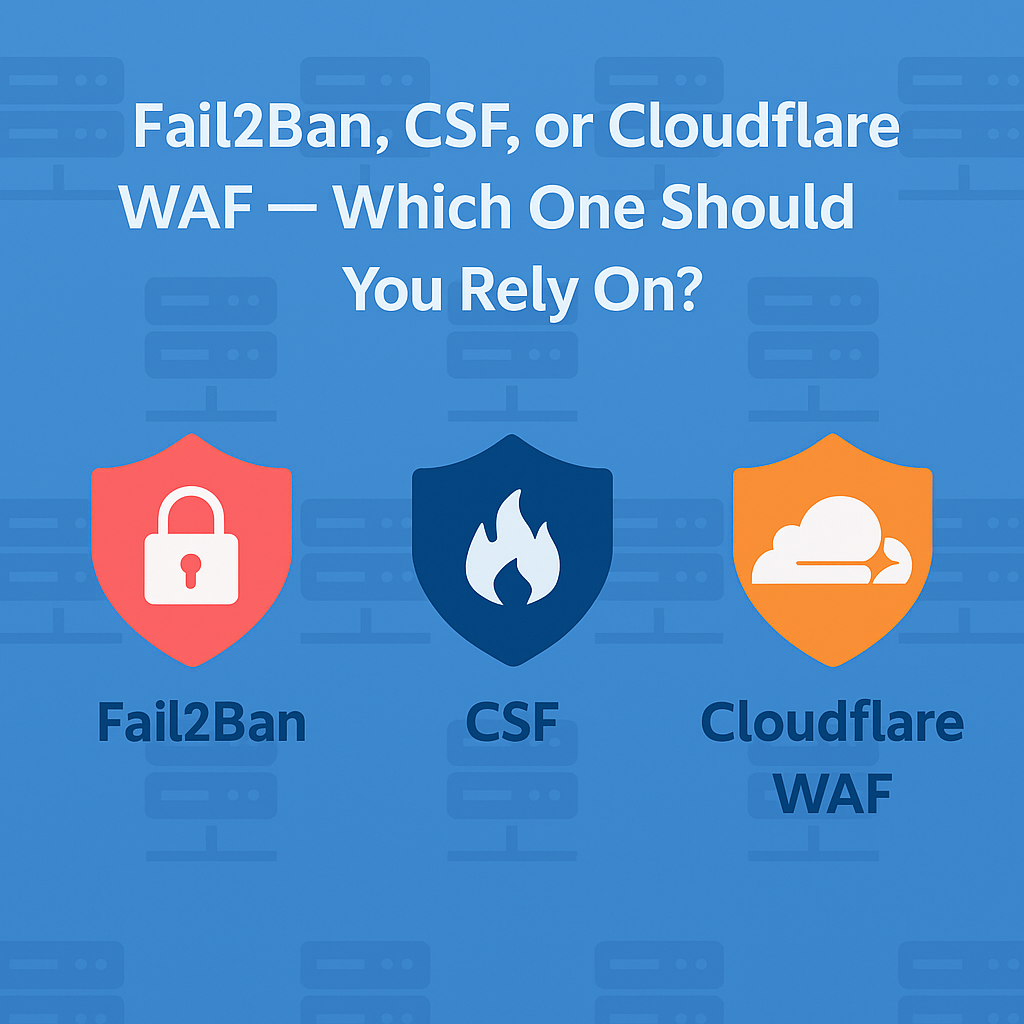
A Practical Guide to Choosing the Right Security Layer for Your Server or VPS
Whether you’re managing a VPS, running a web hosting business, or just hosting your own website, server security is non-negotiable. With rising brute-force attacks, bots, and exploits, tools like Fail2Ban, CSF (ConfigServer Security & Firewall), and Cloudflare WAF are becoming essential — but which one should you rely on?
At HostEONS, we deal with hundreds of VPS and server deployments daily, so here’s our practical take on when, why, and how to choose between Fail2Ban, CSF, and Cloudflare WAF.
🔐 Overview of Each Tool
🔄
Fail2Ban
— Lightweight Intrusion Prevention
Fail2Ban scans log files (SSH, Exim, Apache, etc.) and bans IPs that show malicious signs — like too many failed logins.
Best For:
- SSH protection
- SMTP brute-force protection
- Login abuse monitoring
- Simple automated banning
Strengths:
✅ Lightweight
✅ Easy to configure
✅ Works well on low-resource VPS
Limitations:
🚫 No web-level protection (can’t stop Layer 7 attacks)
🚫 Only reacts after suspicious activity is detected
🔥
CSF (ConfigServer Security & Firewall)
— Full Linux Server Firewall Suite
CSF is a complete security suite for Linux servers. It’s an advanced iptables frontend and includes features like login tracking, port scanning detection, and real-time alerts.
Best For:
- VPS or dedicated servers (especially with cPanel/DirectAdmin)
- In-depth server firewall management
- Advanced port, connection, and user-level restrictions
Strengths:
✅ Deep integration with server control panels
✅ Country-level IP blocking
✅ Brute-force login protection (LFD)
Limitations:
🚫 Steeper learning curve
🚫 Can be overkill for small websites or single-app environments
☁️
Cloudflare WAF
— Cloud-Based Web Application Firewall
Cloudflare WAF operates at the DNS and CDN level, filtering HTTP/S traffic before it even reaches your server.
Best For:
- Websites with public traffic (WordPress, eCommerce, etc.)
- Preventing Layer 7 attacks, XSS, SQLi, bots
- Blocking traffic from abusive geolocations or agents
Strengths:
✅ Stops threats before they hit your server
✅ Rate limiting & bot protection
✅ Managed rulesets + custom WAF rules
✅ Easy IP whitelisting/blacklisting
Limitations:
🚫 Doesn’t protect non-HTTP services (e.g., SSH, SMTP)
🚫 Limited without a paid plan (WAF only on Pro and higher)
💡 So… Which One Should You Rely On?
| Use Case | Recommended Tool(s) |
|---|---|
| Websites (e.g., WordPress, Magento) | ✅ Cloudflare WAF + CSF |
| SSH & SMTP protection on VPS | ✅ Fail2Ban or CSF |
| Multi-tenant hosting (cPanel, DA) | ✅ CSF (with LFD & alerts) |
| Low-resource VPS or LXC container | ✅ Fail2Ban (lightweight & simple) |
| Enterprise DDoS and bot protection | ✅ Cloudflare WAF + Fail2Ban combo |
🧠 Best Practice: Use Them Together!
You don’t always need to pick just one. In fact, combining these tools gives multi-layered protection:
🔹 Fail2Ban = Stop brute-force at service level
🔹 CSF = Manage your full server firewall & alerts
🔹 Cloudflare WAF = Block web-based attacks before they hit your server
💬 At HostEONS, many of our customers run all three — and we actively help configure them via ticket support.
🛠️ What We Recommend at HostEONS
- For most Linux VPS and web hosting environments, we recommend:
- ✅ Fail2Ban + CSF for local security
- ✅ Cloudflare WAF for external filtering and global protection
- We also offer Cloudflare integration and managed firewall assistance upon request.
Looking for help securing your VPS?
🔗 Related Services at HostEONS
- 💻 KVM VPS Hosting
- 🛡️ DDoS protection via Cloudflare
- 📦 DirectAdmin shared hosting with CSF pre-installed
- 💬 One-click install scripts for Fail2Ban and firewall rules